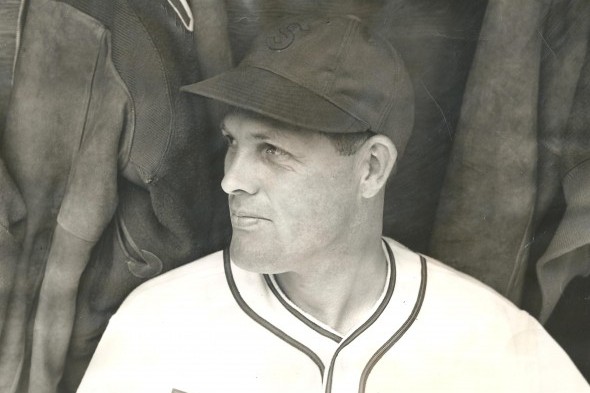
By David Eskenazi and Steve Rudman
Had head coach Babe Hollingbery been just a little more persuasive in his recruiting efforts, Bill Lawrence might have become a star halfback or end on Hollingbery’s great Washington State football team that featured Mel Hein and Turk Edwards and played Alabama in the 1931 Rose Bowl.
Hollingbery tutored the 6-foot-4, 194-pound Lawrence at Lick High School in San Francisco, and tried to lure him to the Palouse after Hollingbery relocated there (1925), convinced that Lawrence possessed the ability to become an All-America player (see Wayback Machine: Hollingbery, Hein, Edwards).

But Lawrence had little inclination to explore the eastern Washington wheat fields. What he really wanted was to attend Stanford University and play for Pop Warner, but he didn’t have the grades. In fact, he barely sported the academic bona fides to cross the portals of San Mateo Junior College.
When Lawrence eked his way of San Mateo JC, after helping lead the school’s football team to the 1925 California Junior College Championship despite a series of leg injuries, he received an offer from Justin Fitzgerald to extend his athletic career at Santa Clara University.
Fitzgerald was not a football coach. He managed the semipro San Mateo Blues, coached the Santa Clara varsity baseball team and scouted for Pacific Coast League clubs. But having watched Lawrence play football, he figured the youngster could easily transition from the gridiron to the diamond.
“I barely touched a baseball in high school,” Lawrence told an interviewer in 1989. “I played a little town ball. I used to watch the (semipro) San Mateo Blues when I was a kid. At the time, I played for Darcy’s, the sporting goods store in town. We’d play in the morning before the Blues played their games. They were pretty famous all over the state.”
To Fitzgerald’s disappointment, Lawrence’s embryonic baseball career went nowhere at Santa Clara, the school ousting him for poor grades.
“Stanford knew I didn’t have the grades but Santa Clara didn’t even ask,” Lawrence said. “After I got kicked out of Santa Clara, Fitzgerald signed me to a contract with the San Francisco Seals, and then the Seals farmed me out to Arizona . . . Globe.”
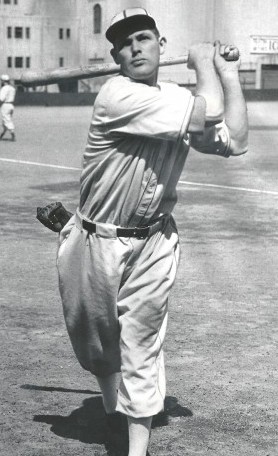
Lawrence finally earned his chance with the Seals in 1929 and played, according to Lawrence’s recollection, “in three or four games,” at which point manager Mickey Shader told Lawrence that he would never make it as a baseball player and sent him home to San Mateo.
But Fitzgerald disagreed with Shader’s assessment and convinced the Seattle Indians to take a chance on the 23-year-old strapper. Since manager Ernie Johnson’s Indians were en route to 135 losses, they didn’t have much to lose.
Johnson showed so little in the 41 games he played — .245 batting average, .292 slugging percentage — that the Indians didn’t even take him on road trips. But the club, hoping he would develop, invited him to 1930 spring training in San Clemente, CA.
Three weeks into camp, Johnson told Lawrence, who had been tried out at first base but had yet to find a position, that he needed more seasoning and recommended a stint with the Miami Miners of the Class D Arizona State League.
A few Seattle players, including Mike Hunt, had toiled in that loop (1929 Globe Bears), but Lawrence balked at a demotion, deciding to take his chances at earning a roster spot in Seattle.
“So they kept me on their roster for a while,” Lawrence said. “But soon they wanted to ship me to Arizona again. Luckily, I started to get some hits.”
The key day for Lawrence was March 30, with only a week remaining in spring training. The Indians were in San Diego, playing the Hollywood Stars, and Johnson penciled in “Ladies Day” Louie Almada at first base.
Almada, though, not expecting to play, hadn’t brought his first base mitt to the ballpark (see Wayback Machine: Lou, Mel – The Almada Brothers).

“That fact might be Lawrence’s meal ticket,” Alex Schults speculated in The Seattle Times. “He started at first instead of Almada and how he played ball! Thrown into the fray, the way he played had the stands cheering for him. He went to the right, to the left, took ’em on the meat hand and threw from strange positions to the pitcher to get the batter.”
Since the Indians had a glut of first basemen but a dearth of outfielders, Johnson, impressed with Lawrence’s speed, installed him in right field. Lawrence covered the position so easily for the first two weeks of the season that Johnson decided to try him in center while veteran regular Cliff Lee nursed an injured leg.
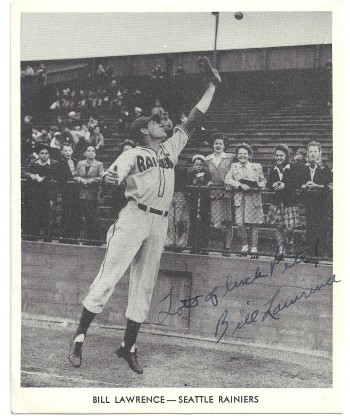
Lawrence played the spot for the first time in the Indians’ home opener April 30 at Civic Stadium, and was rarely out of the Seattle lineup for the next 13 years. Lee, meanwhile, became a minor league version of Wally Pipp.
He played only sporadically in 1930 in what became his last year in Seattle and final year in pro baseball.
Lawrence might have played many more than his 13 seasons, but the hard scrabble of Civic Stadium played havoc with his legs, forcing an initial retirement after the 1942 season at the age of 33 and a final one Jan. 14, 1944, nine months after he was coaxed out of his first retirement.
Lawrence excelled for some of the worst pro baseball teams Seattle has witnessed — the 1929-31, 1934-37 Indians, who lost more than 100 games four times and never finished higher than sixth during the underfunded ownership of William H. Klepper — and for greatest clubs in franchise history, the 1938-41 Emil Sick-owned Rainiers, who won three consecutive PCL pennants (1939-41).
William Henry Lawrence, born March 11, 1906, in San Mateo, began to hit his stride in 1931 when, as the Indians regular center fielder, he hit a career-high .324 with 99 RBIs in 162 games.
Although not much of a slugger – just two home runs in 618 at-bats that season, and only 32 to show for a 15-year minor league career – he demonstrated enough that the Indians, always desperate for a cash infusion, sold him to the Detroit Tigers.
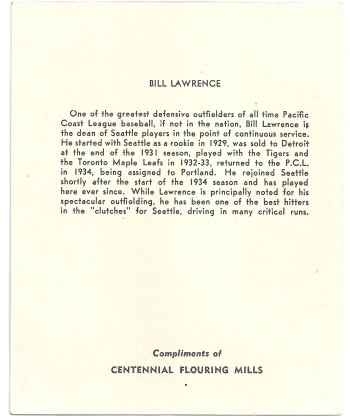
“It’s fitting and proper that Lawrence will get his chance at the majors this year, for his work was easily the feature of a drab season for the Indians (83-104),” The Times editorialized.
“Quite possibly, Bill won’t stick with the Tigers, who will probably farm him to Toronto so he can be called in on short notice. While he is not destined to become a fence buster, his speed and hustle will make him invaluable to a major league club after a little more seasoning.”
As The Times predicted, the Tigers farmed Lawrence to Toronto after he hit just .217 in 25 games.
While Lawrence didn’t get much of an opportunity to impress the Tigers, he made one important connection in his brief stay in Detroit, developing what evolved into a life-long friendship with fellow center fielder Jo Jo White, who became a teammate during the glory years of the Rainiers.
Lawrence spent most of 1932 and all of 1933 with Toronto, Detroit’s AA International League affiliate, and returned to the PCL in 1934 with Portland. Klepper began to dabble with the idea of re-acquiring Lawrence after watching games of May 3-4, 1934.
In the May 3 game, at Portland, Lawrence went 2-for-3, scored a run and made a leaping catch against the wall that deprived Mike Hunt of extra bases in a 4-2 Beavers victory (see Wayback Machine: ‘Old Baggy Pants’).
“Lawrence almost knocked himself out making the catch, but clung to the ball, saving a run,” Alex Schults wrote in The Times.
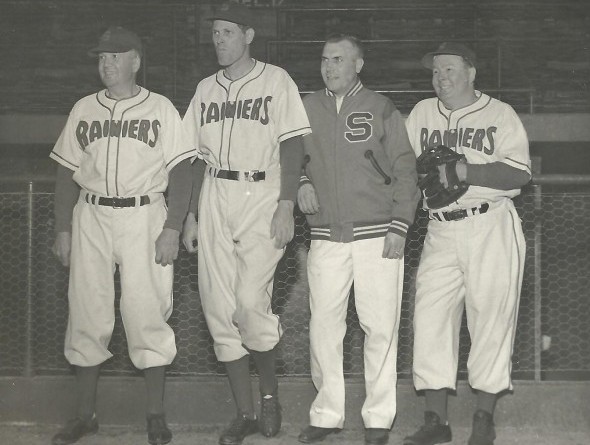
The next day, Lawrence had two more hits, walked twice and made two “outstanding catches,” according to The Times, in a 7-3 Portland victory.
On May 24, Detroit, which still held Lawrence’s rights, recalled him and sent him to the Indians. To make room, the Indians released Jimmy Welsh.
“We’re trying to give Seattle a baseball team that will thrive here,” said Klepper, who largely failed in that pursuit.
Klepper never flourished during his second stint as owner of the Indians and, teetering on bankruptcy, sold the franchise to Sick following the 1937 season (see Wayback Machine: Klepper’s Life Behind An 8-Ball.). But Lawrence flourished when the team relocated to Sicks’ Stadium and became the Rainiers.

“He was the best center fielder I ever saw in the minor leagues,” said Seattle baseball icon Edo Vanni, a long-time teammate of Lawrence’s.
“Also, he’d take strides you couldn’t believe going from first to third. He could have been a great hitter, but he just didn’t have that incentive. If he got a couple of hits and we had a three-run lead, he’d come back and tell the pitcher, ‘That’s enough. You hold the lead.’”
“The man nicknamed ‘High Pockets’ was fearless around the outfield walls, particularly in the PCL’s biggest ballparks,” wrote author Dan Raley in his splendid book, Pitchers of Beer.
“He could run forever and dared anyone to try to launch one over him. New York Yankees legend Joe DiMaggio, who played in the league for the San Francisco Seals before moving up, noted that the Seattle minor leaguer was the best defensive center fielder he ever played against.
“The Rainiers pitchers felt so comfortable with Lawrence standing behind them that they weren’t afraid to groove pitches. Understanding his special skills, the defensive whiz allowed his outfield mates to relax and know that help was always nearby.”
Fred Hutchinson had Lawrence behind him in the Rainiers’ memorable 1938 season. In 1939, after Hutch’s sale to the Detroit Tigers, Hutchinson found himself pitching for the Toledo Mud Hens. Asked about the difference in pitching for Seattle and Toledo, Hutchinson said, “With Toledo, I had no Bill Lawrence out there in center to snag everything hit anywhere near him.”
Buddy Hancken, who caught 71 games for the 1939 Rainiers, agreed with Vanni that Lawrence was without peer as a ball shagger.

“The best center fielder I ever saw was Bill Lawrence and I saw all the great ones,” said Hancken, who played 16 minor league seasons and got into one game for the 1940 Philadelphia Athletics.
“He had that long, loping run. He was tall. He always got there. No one ever hit one over his head and kept it in the park.”
“We’d have to give Bill Lawrence the palm as one of the greatest fly-chasing center fielders that ever lived,” Oregonian sports editor and University of Washington graduate L.H. Gregory wrote. “He’d start after a ball and you’d think, ‘Gee whiz, a sure double, he can’t possibly get there.’ But get there he would, and his long legs ate up the ground.
“He was further aided by very long arms and huge, sure hands. Lawrence ran incredible distances at what must have been very high speed. His circus catches became legendary in the PCL.”
Lawrence enjoyed his three best seasons from 1938-40 when the Rainiers finished second, first and first.
“Lawrence was probably at his peak when the Rainiers moved to Sicks’ Stadium in 1938, for on that springy turf he could roam far and wide,” Schults wrote. “It was there, during that season, that Lawrence made the greatest catch in Seattle history.
“With the bases bulging in the second inning and Schoolboy Freddy Hutchinson in dire pitching trouble, Bill Cronin, roly-poly Portland catcher, drove a terrific wallop against the left-center fence.

“There was one out at the time, but all three Beavers started running. No one could catch a drive like that one. But Lawrence, who had played the light-hitting Cronin in short center, went galloping back and with one final leap caught the ball as he crashed into the fence.
“High Pockets’ wiped a lot of the new paint off the fence with his arm, but clung to the ball. Actually, he made an unassisted double play as the Beaver runners were so confused after returning to bases they passed each other on the paths for an automatic third out.”
Lawrence began to fade in 1941 when leg fatigue limited him to 73 games. He decided to quit in 1942, but his retirement lasted only until mid-season when he returned and saw action in just 40 games. Although he hit .310, he decided to retire again.
In early 1943, Lawrence accepted a position as playfield director for the North King County district. But when the Rainiers stumbled out of the gate and suffered a series of injuries, they coaxed him back for an additional 80 games. He required a rest every few days.
Seattle’s newspapers made quite a splash over what proved to be Lawrence’s final retirement, Jan. 14, 1944, giving it front-page treatment.
“Ol’ High Pockets has informed the Seattle Rainiers not to count on him for the 1944 season, as he’s working for an explosives plant near his home in San Mateo and has decided to stay with the job,” Schults wrote.
“Lawrence is the most popular player ever to perform in a Seattle uniform, and although fans will miss his loping style that carried him leagues across the outfield to haul in sure base hits that saved game after game, they can’t argue with him.
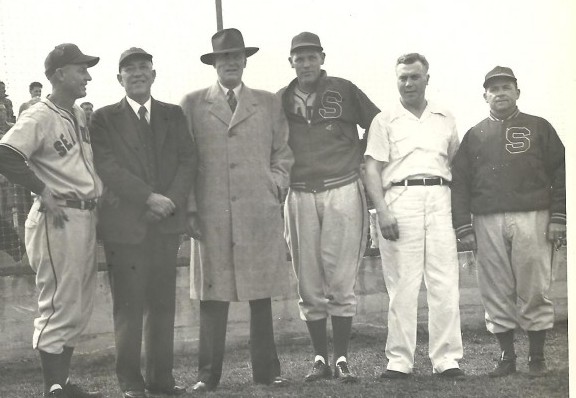
“’Long Poke,’ as the players call the big guy, isn’t old as players go. He’s only 34, but his legs never quite recovered from the beating they took on the hard outfield in the years when the old Seattle Indians played at Civic Stadium.
“In those days, Lawrence used to spend his Mondays soaking his knees in hot baths so that he could chase flies the other days of the week. Never a powerful hitter, Lawrence was a dependable one who always was high in RBIs.
“When a base hit was required, Bill was at his best. At that, Lawrence is the only man who has hit home runs over both fences (left and right) at Sicks’ Stadium (Lou Novikoff and Vince DiMaggio did it after Lawrence).
Lawrence had a career batting average of .289 and drove in 750 runs (742 of them for Seattle) in 1,613 PCL games.
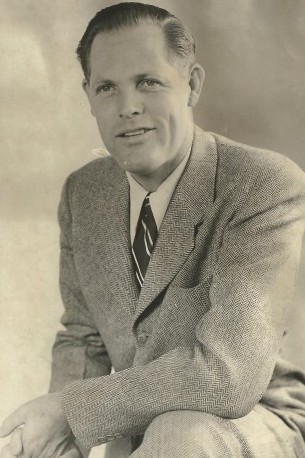
Living in San Mateo, Lawrence ultimately became a full-time scout for the Boston Braves, a position he held until December 1948, when the Braves elected not to renew his contract. By that time, Jo Jo White managed the Rainiers, and White opted to bring Lawrence back to Seattle as his No. 1 assistant.
It didn’t work out. With the Rainiers at 56-54 and in fifth place, Sick fired White and elevated Lawrence to the manager’s seat. He went 39-39 the rest of the way and declined to manage the club in 1949. He scouted for Sick through the 1950 season, when the Rainiers dropped his contract in an economy move.
Lawrence enjoyed one final moment under the spotlight when, in 1954, he made the Rainiers’ 10-man Rainiers Roll of Honor. Lawrence drew 6,926 votes in the balloting by fans, just behind the 7,136 that pitcher Kewpie Dick Barrett received.
Lawrence held several jobs in his post-baseball life, most notably working in a factory near his hometown. He lost his wife of 57 years, Zilpha Lawrence, in 1988, and for his last few years lived in a retirement facility.
The center fielder, described by Seattle writer Darrell Bob Houston as having “the strides of Man O’ War,” died June 15, 1997 at 91 in Redwood City, CA.
In the aftermath of Lawrence’s death, an unsigned letter-to-the-editor lauded Lawrence as the writer’s all-time favorite Rainier. “Great player,” said the missive. “And Bill always had a kind word for the knothole urchins.”
————————————————
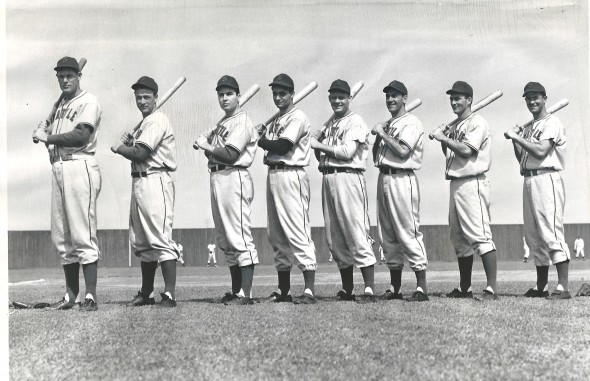
Many of the historic images published on Sportspress Northwest are provided by resident Northwest sports history aficionado David Eskenazi. Check out David’s Wayback Machine Archive. David can be reached at (206) 441-1900, or at seattlesportshistory@gmail.com

1 Comment
Wasn’t Lawrence also known as piano legs or have I confused the players?